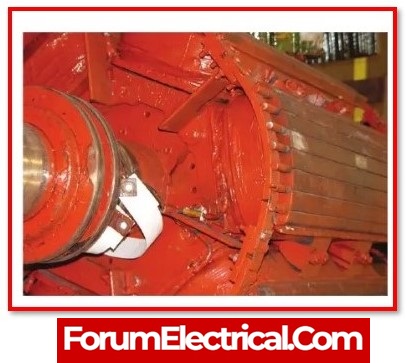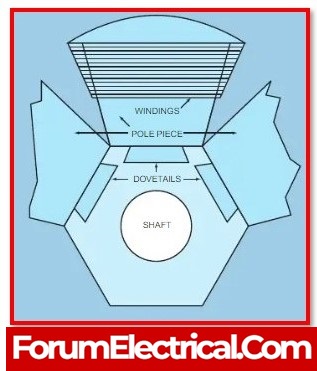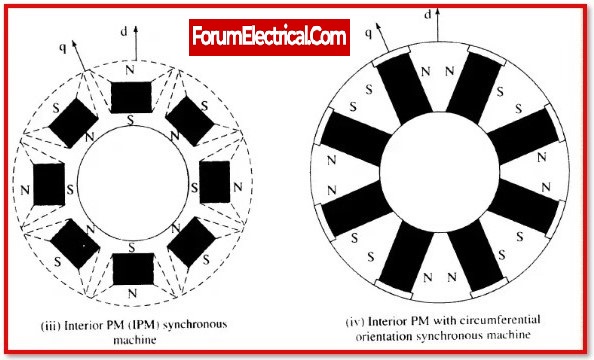- What is Synchronous Motor?
- Construction of the Synchronous Motor:
- Working Principle of a Synchronous Motor:
- Synchronous Motor Characteristics:
- How Does a Synchronous Motor Work?
- What is the purpose of a synchronous motor?
- Synchronous Motor Starting Methods:
- Types of Synchronous Motor:
- What are examples of Synchronous motors?
- Advantages of Synchronous Motor:
- Disadvantages of Synchronous Motor:
- Applications of Synchronous Motor:
What is Synchronous Motor?
A synchronous motor is an alternating current motor in which the shaft rotates at the same rate as the frequency of the applied current. In other words, a synchronous motor operates similarly to an AC motor, except that the total number of rotations made by the shaft in synchronous mode is equal to an integer multiple of the frequency of the applied current.

The synchronous motor does not use induction current to operate. Unlike induction motors, this type of motor features multiphase AC electromagnets on the stator that generate a spinning magnetic field. The rotor in synchronous is made up of a permanent magnet that is synchronised with the revolving magnetic field and rotates in time with the frequency of current given to it.
Construction of the Synchronous Motor:
The two primary components of a synchronous motor are referred to as
- Stator and
- Rotor
respectively.
1). Stator:
When the motor is turned off, the armature winding is wound around the stator, which is what causes the stator to become stationary.

2). Armature Winding:
The electromagnetic field (EMF) that is induced in the motor is caused by the primary winding, which is the armature winding.
3). Field Winding:
The field windings are held in place by the rotator.

4). Rotor:
The primary component of the field flux is induced within the rotor. The rotor can be designed in two different ways, which are referred to as
- Salient Pole Rotor and
- Non-Salient Pole Rotor
respectively.
The salient pole rotor is used in the synchronous motor. The poles of the rotor that are directed toward the armature windings are meant by the phrase salient. Laminations of steel are used in the manufacturing of the rotor that is used in synchronous motors.

Laminations help to cut down on the amount of eddy current loss that can occur on the winding of the transformer. The salient pole rotor is most frequently utilised in the design of the medium and low-speed motor. A cylindrical rotor is utilised within the motor in order to achieve the desired high rotational speed.
Working Principle of a Synchronous Motor:

- The working of synchronous motors is dependent upon the magnetic fields of the stator and the rotor interacting with one another in order to generate the desired output.
- The stator has windings for all three phases, and it receives power in the same configuration. Therefore, a three-phased rotating magnetic field is produced by the stator winding.
- The rotor is provided with a supply of DC current.The spinning magnetic field that is produced by the stator winding causes the rotor to synchronise its rotation with the field as it enters the field. At this point, the speed of the motor is determined by the frequency of the current that is being provided.
- The frequency of the current that is being applied that determines the speed of the synchronous motor. The speed of a synchronous motor can be determined as
Ns=60f/P=120f/p
Where,
f= Frequency of the alternating current (Hz)
p = Total number of poles in each phase.
P = Total pair count of poles for each phase.

- When a load that is more than the motor’s breakdown load is applied, the motor will become out of synchronisation.
- Moreover, using a stator winding with three phases is that it enables to select the rotational direction. It is not feasible to determine the direction of rotation when a single-phase winding is used, and the motor can be started in either of the two potential directions.
- Starting arrangements are required for these synchronous motors in order to control the direction of rotation in the motors.
Synchronous Motor Characteristics:
- Synchronous motors are not self-starting by design. They need some external mechanism to get near to synchronous speed before they can be synced.
- Because the speed of operation is synchronised with the supply frequency, they act as constant speed motors regardless of load condition for constant supply frequency.
- This motor is remarkable in that it can operate under any electrical power factor. As a result, it is utilised to improve the electrical power factor.
How Does a Synchronous Motor Work?
The stator and rotor are the two major components of the synchronous motor, as they are in many other motors. A wrapper plate is affixed to the stator frame of a synchronous motor, to which key bars and circumferential ribs are attached. Footings or frame mounts are utilised to support the machine, and slip rings and brushes are used to excite field windings with DC.

For 6 pole applications, synchronous motors use
- Cylindrical Rotors and
- Round Rotors.
When a large number of poles are required, prominent pole rotors are the ideal solution. A synchronous motor is developed in the same way that a synchronous alternator is assembled.
What is the purpose of a synchronous motor?
The relationship between the magnetic field of the stator and the magnetic field of the rotor. Three phases of power sustain the part of the motor that contains the three phase windings. So, the stator winding makes a rotating magnetic field that has 3 phases and the rotor can be powered by direct current.
The rotating magnetic field that the stator winding makes is where the rotor joins in and rotates at the same speed. The speed of the motor depends on how often the current is sent to it. Actually, the speed of a synchronous motor is controlled by the frequency of the current.
In short, the three-phase stator winding of a synchronous motor carries three-phase current and makes three-phase rotating magnetic flux. On the other hand, the rotor also uses DC power and makes a constant flux. At 50 Hz power frequency, from the above equation that the 3-phase rotating flux makes about 3000 turns in just one minute, or 50 turns in just one second.
In some cases, the rotor and stator poles have the same polarity (N-N or S-S). It causes a force that pushes against the rotor. This polarity will soon be N-S, which causes an attractive force. But because of the rotor’s inertia, that force of attraction or repulsion can’t make it move in any direction, so the rotor stays in a still position. This is the reason a synchronous motor does not start itself.
Synchronous Motor Starting Methods:
1). Starting the motor with an external prime Mover:
Synchronous motors are mechanically connected to other motors. It could be a three-phase induction motor or a direct current shunt motor. DC excitation do not apply at initially. It rotates at a speed extremely near to its synchronous speed, and then the DC excitation is applied. When magnetic locking occurs, the power to the external motor is switched off.
2). Damper winding:
The additional winding is mounted on the rotor pole face of the salient pole synchronous motor. When the rotor is not rotating, the relative speed between the damper winding and the rotating air gap flux is high, resulting in an emf that creates the requisite starting torque. As the speed approaches synchronous speed, emf and torque decrease, and when magnetic locking occurs, torque also decreases to zero. As a result, the synchronous motor initially operates as a three-phase induction motor with additional winding before being synced with the frequency.
Types of Synchronous Motor:
There are two types of synchronous motors based on the method of magnetization of the rotor:
- Non-Excited Synchronous Motor and
- DC Excited Synchronous Motor.
1). Non-Excited Synchronous Motor:
The external stator field magnetises the rotor in these motors. A magnetic field is always present in the rotor. The rotor is made of high retentive steel, such as cobalt steel.
- Permanent Magnet Synchronous Motor,
- Reluctance Motors, and
- Hysteresis Motors
are the three types of non-excited Synchronous Motor.
a). Permanent Magnet Synchronous Motor:

In permanent magnet synchronous motors, a permanent magnet is employed in conjunction with steel to create the rotor. Because the rotor has a continuous magnetic field, induction winding cannot be employed for starting. Gearless elevator motors are being used.
b). Reluctance Motor:
The rotor of a reluctance motor is composed of steel casting with projecting tooted poles. Rotor poles are smaller than stator poles to reduce torque ripples. Squirrel Cage Winding is used to generate starting torque to the rotor. In instrumentation, this motor is used.

c). Hysteresis Motor:
Self-starting motors are hysteresis motors. The rotor is a smooth cylinder composed of magnetically hard high coercivity cobalt steel. These motors are expensive and are utilised in applications requiring precise constant speed. Servomotors are generally utilized.

2). DC Excited Synchronous Motor:
In this type, the rotor is stimulated by the direct current DC that is provided by the slip rings. In addition to it, AC induction and rectifiers are used. These are typically huge models, with specifications such as having more than one horsepower, etc.
What are examples of Synchronous motors?
Examples of applications that use synchronous motors include electric vehicles, robotics, and precision positioning systems and so on.
Advantages of Synchronous Motor:
- It operates at a constant speed known as synchronous speed, which is determined solely by the frequency of the supply and does not alter in response to any variation in the load.
- By raising the field excitation, it is able to function in all three power factor modes: lagging, unity, and leading. Therefore, it is useful for the improvement of the power factor.
- In comparison to an induction motor, it has an efficiency of more than 90%, which is significantly higher.
- When run at slower speeds, they are more efficient and cost-effective than induction motors.
Disadvantages of Synchronous Motor:
- Synchronous motors are not self-starting by their very nature and require additional measures to achieve a speed that is almost synchronous when first turned on.
- If the load reaches the limit for the breakdown, it comes to a stop.
- For the excitation of its rotor field, it needs a DC source that is external.
- Its speed is fixed, and the only way to change it is to adjust the supply frequency using the variable frequency drive (VFD) variable frequency drive.
- When load is applied suddenly to a synchronous motor, hunting will occur in the motor.
- Because of the slip rings and brushes, it needs to be maintained on a regular basis.
- In comparison to induction motors, synchronous motors are typically more difficult to construct and more expensive.
Applications of Synchronous Motor:
- Synchronous motors are quite common in applications that require a constant speed.
- In addition, motors of this type are utilised in devices such as grinders, pulp beaters, rock crushers, ball mills, steel mills, metal rolling mills, cement mills, rubber and textile mills, centrifugal pumps, air compressors, fans, blowers, line shafts, turn tables, timers, clocks, juicers, tape recorders and players, mixtures, signalling devices, indicating devices, regulating devices, and controlling devices.









